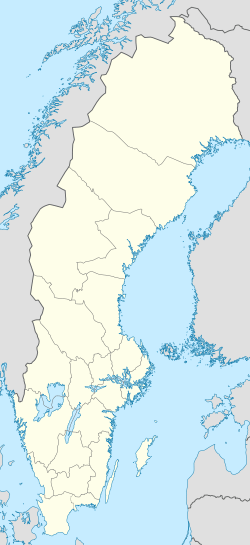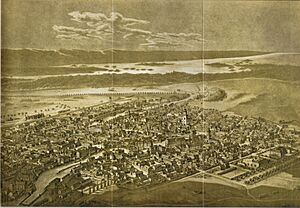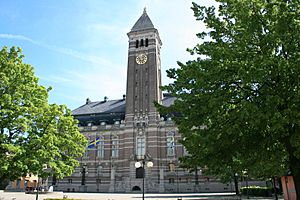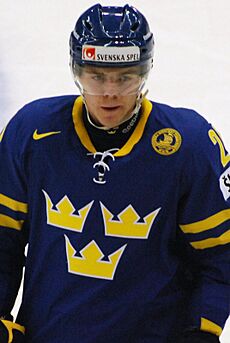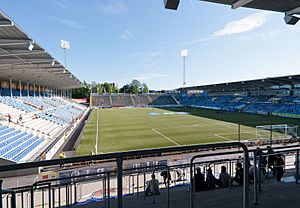Norrköping facts for kids
Quick facts for kids
Norrköping
|
|
|---|---|
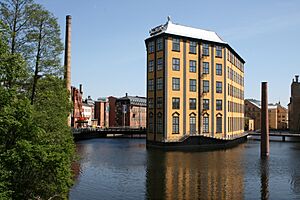
The Strykjärnet (Clothes Iron) building on the Motala River with the Museum of Work
|
|
| Nickname(s):
Peking, Little Manchester
|
|
| Country | |
| Province | Östergötland |
| County | Östergötland County |
| Municipality | Norrköping Municipality |
| Area | |
| • Total | 35.68 km2 (13.78 sq mi) |
| Population
(31 March 2016)
|
|
| • Total | 137,326 |
| • Density | 2,446/km2 (6,340/sq mi) |
| Time zone | UTC+1 (CET) |
| • Summer (DST) | UTC+2 (CEST) |
| Website | norrkoping.se |
Norrköping is a city in eastern Sweden. It is located in the Östergötland County, about 160 kilometers (100 miles) southwest of the capital city, Stockholm. In 2016, Norrköping was Sweden's tenth largest city.
The city sits where the Motala ström river meets Bråviken, an inlet of the Baltic Sea. The river's strong water power and the good harbour helped Norrköping grow quickly. It was once a major industrial city, especially known for its textile factories. People sometimes call it "Sweden's Manchester" or "Peking".
Contents
History of Norrköping
Norrköping started as a medieval settlement. People built mills using the river's waterfalls and rapids. The river was also full of fish like salmon. There are records of a church in the 12th century, dedicated to Saint Olaf.
The city's name first appeared in 1283. Norrköping likely became a city in the early 1300s. The oldest document confirming this is from 1384. The name "Köping" means "market," and "Norr" means "north." There is also a nearby town called Söderköping, which means "South market."
Norrköping faced many battles and fires over the centuries. Because of this, none of the original medieval buildings remain. During the Northern Seven Years' War (1563–1570), a large part of the city burned down. King John III of Sweden helped rebuild it and designed the streets you see today.
In 1618, a weapon factory started here, encouraged by King Gustavus Adolphus. The city's port also became busy because of nearby industries. A large textile industry began, helped by a businessman named Louis De Geer (1587–1652). When De Geer died, Norrköping had 6,000 people and was Sweden's second largest city.
The city burned down again in 1655 and then completely in 1719 during the Russian Pillage of 1719-21. Stones from the old Johannisborg castle were used to build new houses. Today, only a few stones of the castle are left.
During the 1700s, Norrköping was rebuilt. New industries, like sugar refineries and a large snus (a type of tobacco) industry, grew. Many old buildings and churches, like Saint Olof and Saint Hedvig, are from this time. In 1762, Sweden's first theater outside Stockholm, the Egges Teater, opened here.
Norrköping became very important again. In 1769, the Swedish Riksdag (parliament) met in the city. In 1800, King Gustav IV of Sweden was crowned in the Church of Saint Olof.
More fires hit the city in 1822 and 1826. After that, building wooden houses was not allowed. In 1841, a ship-building industry started. By 1850, it was Sweden's largest, with over 600 workers. Industries kept growing throughout the 1800s. A cotton factory and a paper mill (built in 1854) were set up by the Motala Stream. The paper mill still exports paper worldwide today.
The textile industry continued to grow into the 1900s. In 1950, 54 factories employed 6,600 people. However, by 1956, many closed due to competition from other countries. By 1970, only a few factories remained. The famous Holmen paper mill, which had been around for 350 years, also closed. To help the city, some government offices moved to Norrköping from Stockholm.
Since 2002, Norrköping has been growing again, becoming a center for culture and education. The city's symbol represents this "new" Norrköping.
Main Sights
The Motala ström river flows through Norrköping. Along the river, you can see the "industrial landscape" where old textile factories once stood.
In summer, Carl Johans Park has a huge cactus display with 25,000 cacti planted each year.
Kolmårdens Djurpark is a large zoo about 30 kilometers (19 miles) north of Norrköping. Next to the zoo is Tropicariet, an aquarium where you can see snakes, crocodiles, and sharks.
The beautiful archipelagos of St Anna and Gryt are about 50 kilometers (31 miles) from Norrköping.
Other interesting places include a campus of Linköping University, the city's own symphony orchestra, and Norrköping Airport. There is also Norrköping Science Park, a high-tech business area, and ancient Petroglyphs (rock carvings) from the Nordic Bronze Age.
Climate
Norrköping has a climate that is usually mild, with four seasons. It's near the Baltic Sea, but it doesn't get a lot of rain. The average rainfall between 1961 and 1990 was about 508.2 millimeters (20 inches). Even with less rain, the area stays green because of the humidity. Winter usually has low precipitation, often as snow.
The hottest temperature ever recorded in Norrköping was 35.6°C (96.1°F) in July 2022.
| Climate data for Norrköping (2002–2022 averages; extremes since 1944) | |||||||||||||
|---|---|---|---|---|---|---|---|---|---|---|---|---|---|
| Month | Jan | Feb | Mar | Apr | May | Jun | Jul | Aug | Sep | Oct | Nov | Dec | Year |
| Record high °C (°F) | 12.1 (53.8) |
13.7 (56.7) |
18.6 (65.5) |
27.5 (81.5) |
28.6 (83.5) |
33.3 (91.9) |
35.6 (96.1) |
34.8 (94.6) |
27.8 (82.0) |
23.0 (73.4) |
17.2 (63.0) |
13.3 (55.9) |
35.6 (96.1) |
| Mean maximum °C (°F) | 7.8 (46.0) |
8.3 (46.9) |
13.9 (57.0) |
19.7 (67.5) |
24.6 (76.3) |
28.6 (83.5) |
29.5 (85.1) |
28.4 (83.1) |
23.1 (73.6) |
17.0 (62.6) |
12.3 (54.1) |
8.5 (47.3) |
30.6 (87.1) |
| Mean daily maximum °C (°F) | 1.2 (34.2) |
1.9 (35.4) |
6.1 (43.0) |
11.9 (53.4) |
17.1 (62.8) |
21.4 (70.5) |
23.5 (74.3) |
22.3 (72.1) |
17.6 (63.7) |
11.1 (52.0) |
6.0 (42.8) |
2.7 (36.9) |
11.9 (53.4) |
| Daily mean °C (°F) | −1.4 (29.5) |
−1.0 (30.2) |
2.0 (35.6) |
6.7 (44.1) |
11.7 (53.1) |
16.0 (60.8) |
18.4 (65.1) |
17.3 (63.1) |
13.3 (55.9) |
7.8 (46.0) |
3.7 (38.7) |
0.4 (32.7) |
7.9 (46.2) |
| Mean daily minimum °C (°F) | −3.9 (25.0) |
−3.9 (25.0) |
−2.1 (28.2) |
1.4 (34.5) |
6.2 (43.2) |
10.6 (51.1) |
13.3 (55.9) |
12.5 (54.5) |
9.0 (48.2) |
4.4 (39.9) |
1.4 (34.5) |
−2.0 (28.4) |
3.9 (39.0) |
| Mean minimum °C (°F) | −14.4 (6.1) |
−13.0 (8.6) |
−9.8 (14.4) |
−4.3 (24.3) |
−0.3 (31.5) |
5.2 (41.4) |
8.8 (47.8) |
6.9 (44.4) |
2.1 (35.8) |
−3.0 (26.6) |
−6.2 (20.8) |
−11.1 (12.0) |
−16.9 (1.6) |
| Record low °C (°F) | −28.1 (−18.6) |
−33.5 (−28.3) |
−24.4 (−11.9) |
−13.2 (8.2) |
−4.0 (24.8) |
−0.1 (31.8) |
4.9 (40.8) |
2.3 (36.1) |
−4.6 (23.7) |
−9.0 (15.8) |
−15.9 (3.4) |
−24.7 (−12.5) |
−33.5 (−28.3) |
| Average precipitation mm (inches) | 36.1 (1.42) |
30.5 (1.20) |
28.5 (1.12) |
26.9 (1.06) |
48.7 (1.92) |
57.0 (2.24) |
71.6 (2.82) |
69.0 (2.72) |
38.3 (1.51) |
53.2 (2.09) |
47.8 (1.88) |
40.1 (1.58) |
547.7 (21.56) |
| Average extreme snow depth cm (inches) | 15 (5.9) |
18 (7.1) |
12 (4.7) |
2 (0.8) |
0 (0) |
0 (0) |
0 (0) |
0 (0) |
0 (0) |
0 (0) |
5 (2.0) |
11 (4.3) |
24 (9.4) |
| Average precipitation days (≥ 1 mm) | 8.4 | 7.1 | 6.2 | 6.0 | 8.2 | 8.6 | 8.8 | 9.8 | 7.5 | 9.5 | 10.0 | 9.7 | 99.8 |
| Mean monthly sunshine hours | 46.3 | 75.9 | 168.4 | 232.7 | 264.3 | 282.0 | 268.3 | 228.8 | 168.5 | 103.2 | 46.6 | 37.7 | 1,922.7 |
| Source 1: SMHI Open Data | |||||||||||||
| Source 2: SMHI Monthly Data 2002–2022 | |||||||||||||
Famous People from Norrköping
Many well-known people come from Norrköping, including:
- Hannes Alfvén – a physicist who won the Nobel Prize.
- Amy Diamond – a singer.
- Peter Harryson – an actor and entertainer.
- Ove Kindvall - a famous soccer player.
- Magnus Pääjärvi-Svensson – an NHL hockey player.
- Pernilla Wiberg – an alpine skier who won two Olympic gold medals.
- Carl Swartz – a former prime minister of Sweden.
Sports in Norrköping
Norrköping has several sports teams:
- HC Vita Hästen (Ice hockey)
- IFK Norrköping (Association football)
- Norrköping Dolphins (Basketball)
- Norrköpings KK (Swimming)
- NRK Troján (Rugby)
Speedway Motorcycle speedway races happen at the Norrköping Motorstadion. The local team, Vargarna, races there. They have won the Swedish Speedway Team Championship six times.
Transport and Connections
Norrköping is a great place for businesses that move goods. It has a deep-sea harbor, a major railway line, Norrköping Airport, and is where two main European roads (E4 and E22) meet. The city also has government agencies and university programs focused on transport and logistics.
Norrköping is part of the East Link, a big railway project. This project will make train travel faster and allow more goods to be transported. As part of this, a new freight railway line called Kardonbanan opened in 2021, connecting the harbor to the main railway.
Norrköping is one of only two cities in Sweden (the other is Gothenburg) that still has its tram system.
Culture in Norrköping
Film and Visualization
Norrköping is a hub for film and visualization. Cnema, a film club, started in the 1960s and became a cinema in 2010. It is next to Visualization Center C and Linköping University. Here, you can experience 3D movies in an 8K dome cinema.
The film group Crazy Pictures is based in Norrköping. They have made movies like The Unthinkable (2018) and UFO Sweden in the city.
Author Emelie Schepp writes crime novels set in Norrköping. Her main character, Jana Berzelius, works for the Norrköping Public Prosecution Office. A TV show based on one of her books, Jana: Marked for Life, was filmed in Norrköping in 2024.
Museums
- Norrköpings konstmuseum (Norrköping Museum of Art) focuses on modern and contemporary Swedish art. It was founded in 1901 and is located next to the City Library.
- Norrköpings stadsmuseum (Norrköping City Museum) opened in 1981. It tells the story of the city, especially its industrial past. The museum is in the old industrial area by the river. It also cares for many Bronze Age rock carvings and ancient sites around the city.
- Museum of Work (Arbetets museum) is in the famous Strykjärnet building, which used to be a weaving mill. This museum collects personal stories about people's work and daily lives. It also has the EWK – Center for Political Illustration Art, featuring the work of cartoonist Ewert Karlsson.
- Ståhl Collection opened in 2020. It holds the private art collection of local businessman Mikael Ståhl. The museum is in the old industrial area and displays paintings and sculptures from the 1950s to today.
Music
The Norrköping Symphony Orchestra (Norrköpings symfoniorkester, SON) is a professional orchestra with 85 musicians. They perform at the De Geerhallen concert hall in the city center.
Theatre
Norrköping has a long history of theater. The East Gothland Theatre, opened in 1908, is Sweden's biggest regional theater.
Egges Theatre was the first place in Scandinavia to perform Shakespeare's Romeo and Juliet in 1776.
The Arbisteatern dates back to 1865. Its name means "The theater of Norrköping's worker society."
See also
 In Spanish: Norrköping para niños
In Spanish: Norrköping para niños



